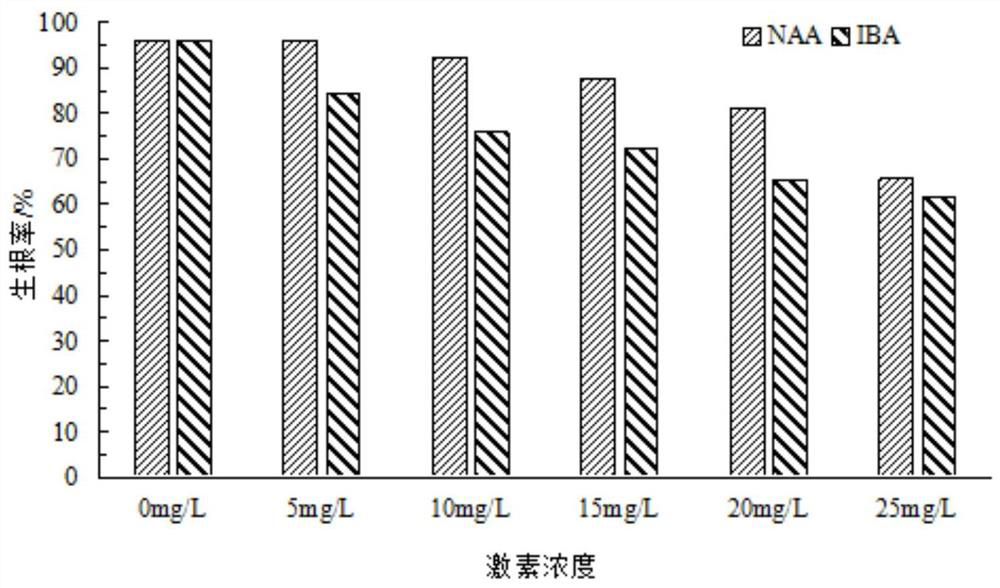Hydrangea breeding method
A technology of hydrangea and cuttings, applied in the field of hydrangea breeding, can solve the problems of high cost, complicated procedures, and complicated operation, and achieve the effect of large number of roots, high rooting rate, and simple operation
- Summary
- Abstract
- Description
- Claims
- Application Information
AI Technical Summary
Problems solved by technology
Method used
Image
Examples
Embodiment 1
[0047] The branches of the same year with the same growth were selected as the research object. Cut each branch into upper, middle and lower cuttings, and keep two nodes for each cutting, with a length of 10 cm. When pruning cuttings, the incision is smooth, the upper incision is 2 cm from the upper end node, and the incision is flat; the lower end incision is 2 cm from the lower end node, the incision is an oblique incision, and the incision angle is 45 degrees. Keep 2 leaves at the node at the upper end of the cuttings, keep 1 / 2 the size of the leaves, and remove all the leaves at the node at the lower end.
[0048] Take 30 cuttings and culture them in sterile water, and replace the sterile water every 24 hours. The light and dark culture conditions are 16h / 8h, and the temperature is set to 25°C under light culture conditions, and 20°C under dark culture conditions.
Embodiment 2
[0050] The branches of the same year with the same growth were selected as the research object. Cut each branch into upper, middle and lower cuttings, and keep two nodes for each cutting, with a length of 10 cm. When pruning cuttings, the incision is smooth, the upper incision is 2 cm from the upper end node, and the incision is flat; the lower end incision is 2 cm from the lower end node, the incision is an oblique incision, and the incision angle is 45 degrees. Keep 2 leaves at the node at the upper end of the cuttings, keep 1 / 2 the size of the leaves, and remove all the leaves at the node at the lower end.
[0051] Take 30 cuttings for culture in sterile water, replace the sterile water every 24 hours, the concentration of NAA in the sterile water is 5mg / L, the light and dark culture conditions are 16h / 8h, and the temperature is set to 25°C under light culture conditions, The temperature was set at 20 °C under dark culture conditions.
reference example 1
[0053] The branches of the same year with the same growth were selected as the research object. Cut each branch into upper, middle and lower cuttings, and keep two nodes for each cutting, with a length of 10 cm. When pruning cuttings, the incision is smooth, the upper incision is 2 cm from the upper end node, and the incision is flat; the lower end incision is 2 cm from the lower end node, the incision is an oblique incision, and the incision angle is 45 degrees. Keep 2 leaves at the node at the upper end of the cuttings, keep 1 / 2 the size of the leaves, and remove all the leaves at the node at the lower end.
[0054] Take 30 cuttings for culture in sterile water, replace the sterile water every 24 hours, the concentration of NAA in the sterile water is 10mg / L, the light and dark culture conditions are 16h / 8h, and the temperature is set to 25°C under the light culture conditions, The temperature was set at 20 °C under dark culture conditions.
PUM
| Property | Measurement | Unit |
|---|---|---|
| Length | aaaaa | aaaaa |
Abstract
Description
Claims
Application Information
 Login to View More
Login to View More - R&D Engineer
- R&D Manager
- IP Professional
- Industry Leading Data Capabilities
- Powerful AI technology
- Patent DNA Extraction
Browse by: Latest US Patents, China's latest patents, Technical Efficacy Thesaurus, Application Domain, Technology Topic, Popular Technical Reports.
© 2024 PatSnap. All rights reserved.Legal|Privacy policy|Modern Slavery Act Transparency Statement|Sitemap|About US| Contact US: help@patsnap.com










